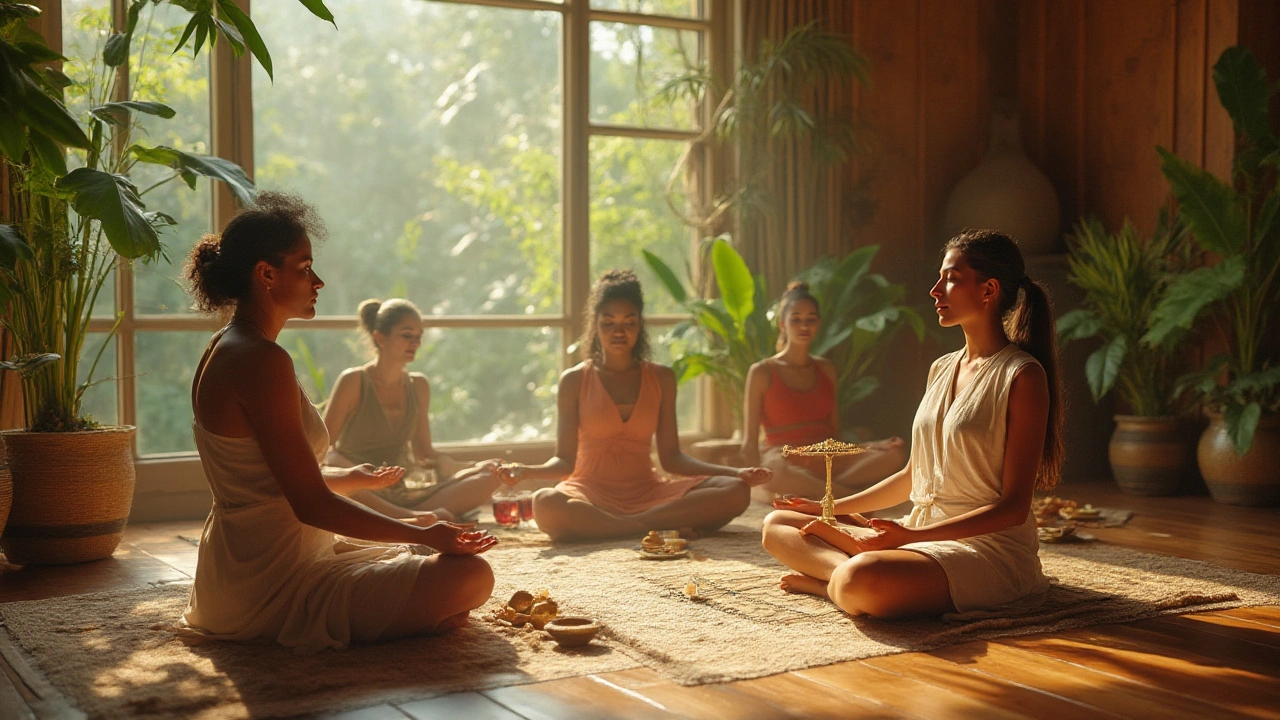Imagine having knots so tight in your shoulders you feel years older than you actually are. Now picture someone kneading all that tension away—not just working on muscles but somehow easing your mind, too. That's the almost-magical reputation of Ayurvedic massage, a centuries-old practice that draws on the science of life itself. Curious how warm herbal oils and unique techniques from ancient India bridge body and soul? This isn’t just a spa day; it’s an entire philosophy of healing.
What is Ayurvedic Massage? The Roots of the Practice
Ayurvedic massage, or Abhyanga, has been part of Indian tradition for over 2,000 years. It’s rooted in Ayurveda, a holistic health system that literally means “knowledge of life.” Unlike Western massages which usually focus on physical relaxation or sore spots, Ayurvedic massage is way more personalized and dives into your whole being. Here, the practitioner takes your body type, known as your "dosha," into account—Vata, Pitta, or Kapha. Each dosha is linked to specific qualities, like dryness or heat. Even the oil they choose depends on what will rebalance your dosha.
Ayurvedic texts describe Abhyanga as “snehana,” which means both “oiling” and “love.” Kind of romantic, right? The oil isn’t just for slipperiness. Traditional Ayurvedic oils are cooked for hours with herbs like ashwagandha or brahmi, each chosen for what your mind and body need most. Practitioners might spend years learning how to blend oils—and yes, your skin feels amazing, but there’s more to it than being soft and shiny. These herbal oils are actually absorbed through the skin, entering the lymphatic system and affecting circulation, immunity, and mood.
What's wild is that the ancient texts also describe the specific direction of strokes to aid lymph movement—long straight strokes on the limbs, circular on the joints. Ayurveda always has a reason for everything. It’s not about mindlessly rubbing; it’s almost like pressing the right buttons for your whole system.
Modern research backs up what those old rishis figured out. One small Indian study in 2022 showed a 20% reduction in stress hormone levels after just four sessions of Abhyanga. Another survey found that people reported feeling “at peace,” experiencing “deeper sleep,” and even seeing their digestion and skin improve. It’s not a miracle cure, but you can see this isn’t just hype—it’s a legit, deeply cultural practice backed by a growing number of studies.
Signature Techniques and the Role of Oils
Step into an Ayurvedic massage room, and you’ll probably smell sesame or coconut oil before you see anything else. The choice of oil isn’t random. Sesame is warming, great for Vata types and cold weather. Coconut oil, which cools, fits fiery Pitta types or a hot climate. Mustard oil may show up if you need help boosting circulation—though it’s a little too intense for some. You might even see blends with neem (awesome for skin problems) or jasmine (relaxing and a mood enhancer).
The actual method feels different from standard Swedish or deep-tissue massages. Expect synchronized strokes if done by two therapists (called four-hand Abhyanga), rhythmic pressing with the whole palm, circular movements around joints, and lots of oil—seriously, you’ll glisten. Sometimes therapists use specialized herbal powders ("udvartana") or even bags filled with warm rice or sand to scrub and energize the body.
Abhyanga isn’t just a luxury you treat yourself to once a year. Traditional guidance suggests daily massage, even if you do it yourself before your morning shower! Got five minutes to spare? Warm up a little oil and rub it on your limbs in long strokes before bathing. It’s said to boost circulation and keeps your skin baby smooth. In India, it’s not unusual for elderly folks, pregnant women, and even newborns to get regular oil massages as a gentle daily ritual.
Here’s a tip: The right oil temperature matters. Oil should feel cozy, not hot. Practitioners might leave a brass bowl of warming oil near a candle or on a water bath. When you do it yourself, test a little in your inner wrist to mimic the pros.
Feeling skeptical about all that oil? It absorbs quickly, especially if your skin’s thirsty. You’ll want a dedicated towel and maybe pay attention to your bathroom floor. Slip-and-slide isn’t relaxing—but neither is scrubbing up a puddle later.

Real Benefits: How Ayurvedic Massage Works on Body and Mind
People don’t keep booking Ayurvedic massages because they enjoy feeling greasy (well, mostly). The truth is, benefits go deep. First, there’s the obvious one: muscle relaxation. By flooding the body with warm oil and rhythmic pressure, tension melts away. But that’s really just the start.
Ayurvedic massage is famous for its impact on the nervous system. After a session, most people report a sweet heaviness or a calm clarity, almost like meditation. Ayurveda says the skin is the “gateway to consciousness.” The nerves soak up soothing signals, and the whole system shifts out of the frantic fight-or-flight urge modern life triggers.
Tangible perks include better sleep, stronger immunity, improved digestion, and clearer skin. Studies even note lower blood pressure after a course of treatment. Ever heard how stress can fry your brain over time? Ayurvedic massage helps fix that by lowering cortisol and triggering the release of feel-good chemicals like serotonin.
The practice also boosts lymphatic drainage. Your lymph system is like your body’s unsung cleanup crew, hustling toxins out and keeping swelling in check. Ayurvedic strokes are tailored to keep this river of health moving. With better circulation, you can expect more color in your cheeks, warmer hands and feet, and less stiffness when you stand up after sitting for hours.
Something you don’t often hear: regular Abhyanga is believed to “slow aging.” Now, that’s a bold claim. According to Ayurveda, keeping the skin nourished with herbal oil protects against environmental stress and keeps joints lubricated. It can’t turn back the clock, but radiant skin and limber joints sure make you feel younger.
Mentally, the benefits keep coming. Many folks use it to ground anxiety, treat mild depression, or simply get a rare hour away from screens. If your idea of self-care is a bath bomb once a season, this goes way deeper. The combination of touch, herbal chemistry, and focused breath brings a sense of wholeness Western massage rarely tries for.
| Benefit | How Fast? | Typical Result |
|---|---|---|
| Lower stress & anxiety | 1-2 sessions | Better sleep, chill mood |
| Smoother skin | 1-3 weeks | Lasting softness |
| Pain relief | 1-4 sessions | Looser muscles, less pain |
| Boosted immunity | After 2+ weeks | Fewer colds & sickness |
How a Session Unfolds: What to Expect Your First Time
If you’ve only had Western-style massage, your first Ayurvedic session can be a surprise. Let’s walk through it. Before you even get on the table, the therapist might ask about your sleep, digestion, recent stress, and even weird questions like what kind of weather you hate most. That’s the dosha quiz in action! They’ll pick an oil blend that matches what your body needs—maybe something cooling if you run hot, or warming if you feel stuck and sluggish.
You’ll be asked to undress (most folks keep on disposable undies) and lie on a warm, sturdy table. Privacy is respected, and only the areas being worked on are usually exposed. Warm oil flows in generous streams along each limb. Therapists start slow, letting it soak in, and then start a rhythm that’s both soothing and invigorating. Expect long sweeping strokes from ankle to hip, circular moves around shoulder joints, scalp massage, and sometimes gentle work on the belly. Don’t be surprised if you’re asked to roll over and have your chest, face, or even feet treated with equal care. (Feet, by the way, are important—Ayurveda says you have energy points there that connect to vital organs.)
Some clinics add optional extras: steam baths (to open pores and detox your skin), herbal compresses, or quiet chanting in the background. Others keep it simple and focus 100% on the massage experience itself. At the session’s end, you’ll usually get a warm towel rub to remove extra oil, and some time to relax before getting dressed. You might feel like jelly or floaty—don’t book anything stressful immediately after.
Newbies sometimes worry about allergic reactions or breakouts, but authentic Ayurvedic spas use pure oils and gentle herbs. Still, if you’ve never tried sesame oil in particular, do a small patch test first to be sure you don’t react.
After your session, drinking warm water or light herbal tea helps flush out everything your newly active lymph system stirred up. Skip heavy meals and stressful activities for a few hours—the whole point is to let the benefits settle in.

Simple Home Rituals and Insider Tips for Lasting Results
The real magic? You don’t need a pro to get many Ayurvedic massage benefits. Daily self-massage is a core part of Ayurveda’s approach to health. If your mornings are rushed, even three minutes makes a difference. Here’s a quick guide:
- Pick the right oil for your dosha or climate—sesame for winter, coconut in summer.
- Warm the oil just a little (try a bowl in hot water, not the microwave).
- Start with your scalp. Use fingertips to press gently, then move down the neck, chest, and arms in long strokes.
- Use circles on joints, especially elbows and knees.
- Work down to your feet, spending time on the arches and toes.
- Let the oil soak in for 5-15 minutes before a warm shower.
This daily routine can be a game changer for dry skin, restless sleep, and even mood swings. If time’s tight, just focus on the feet and scalp. According to ancient practitioners, each sandalwood-scented minute helps the whole system reset.
And here’s something fun—not all Ayurvedic massage is about lying still. There’s also “marma therapy,” where pressure is applied to vital points (like acupressure), used for boosting energy and balancing emotions.
If you want to go deeper, look for certified Ayurvedic practitioners rather than generic spas. The right therapist will take time to read your pulses, ask about your lifestyle, and hand-blend ayurvedic massage oils so your session feels tailor-made. In big cities, authentic clinics might even offer yoga or food advice alongside the massage to round out your healing journey.

